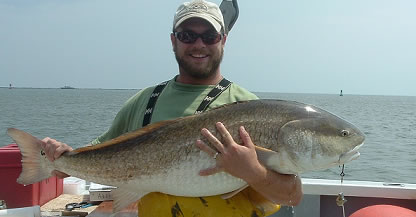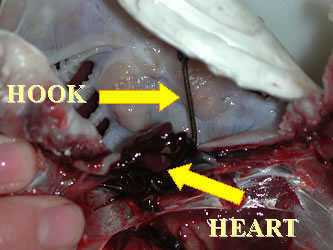Inshore Fisheries Research Section
Red Drum - Scientific Catch-and-Release Studies

Description of Studies
This portion of the study was conducted independently of recreational fishing operations. The purpose of this study was to test the most popular types of fish hooks used by anglers to determine differences in catch-and-release mortality.
In the end, this study concluded that non-offset circle hooks gut-hooked the fewest number of fish, and allowed the release of the largest number of fish alive.
There are two separate studies described in this section:
| Small Hook Study | Large Hook Study |
|---|---|
| Targeting sub-adult red drum (12-27 in. TL) in shallow (1-5 ft) water |
Targeting adult red drum (30+ in. TL) in deep (30-45 ft) water |
| Light tackle, spinning rods | Longline gear |
| 2/0 J-hook 4/0 Circle hook 4/0 Circle hook offset to 15 degree angle |
7/0 J-hook 9/0 Circle hook |
Small Hook Study
(juvenile red drum in shallow water)Fish were caught in a way which approximates normal recreational angler practices. J-hooks were set, circle hooks were reeled in with steady pressure. The line was cut and the hook left in place for all fish that swallowed the point of the hook below the crushing plates in the back of the throat. Handling time was minimized to assess hooking effects, not artifacts from handling stress.
All sub-adult red drum were held at SCDNR's MRRI in 12-ft. diameter, 3-ft. deep tanks to assess 48-hour hooking mortality. Fish that survived the 48-hour holding period were tagged and released at their original capture site.
Results
172 total juvenile red drum were captured.
Most mortalities in this study happened quickly (within a few hours). Some fish were hooked in the heart and bled out quickly. In some, the hook penetrated the stomach and pierced another vital organ, such as the liver. These fish also bled out within a few hours.
Two fish died in the holding tank after about 36 hours. Neither fish had visibly bled out. Not all gut-hooked fish died within the study period, as expected. Interestingly, it was not easy to predict which of the gut-hooked fish would survive.
| This picture shows a juvenile red drum that had been hooked in the heart. It bled out within 30 minutes. |  |
| This image shows a juvenile red drum that had swallowed the hook into the stomach. The hook penetrated the stomach wall and pierced the liver. Notice the large amount of blood inside the body cavity. |  |
| Non-offset Circle hook |
Offset Circle hook |
J-hook  |
|
| Hooked Shallow (Lip or Tongue) |
90% | 81% | 60% |
| Hooked Deep (Gills or Gut) | 10% | 19% | 40% |
| Died within 48 hours | 2% | 10% | 7% |
As you can see from the above table, the greatest percentage of gut-hooked fish were caught on J-hooks.
Non-offset circle hooks were least likely to gut-hook fish and showed the greatest survival rate.
